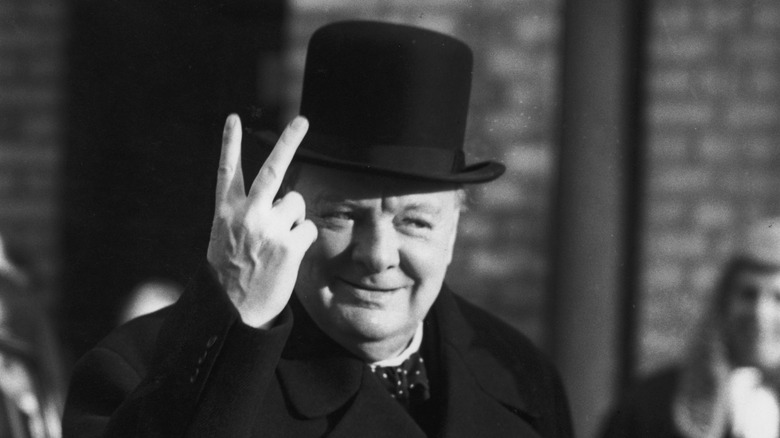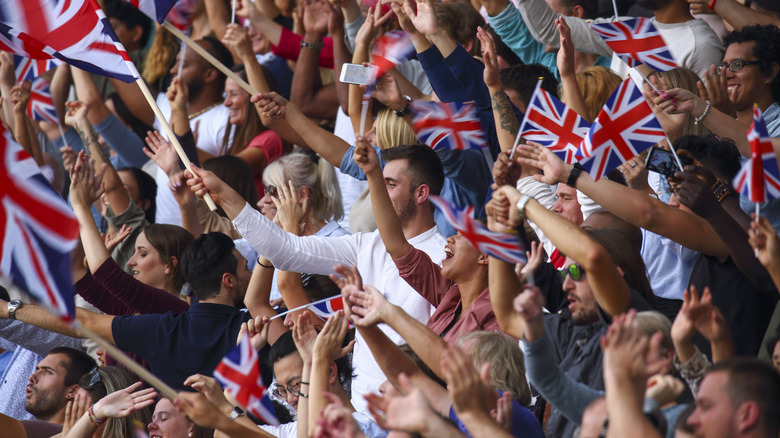Rick Steves Shares Why A Peace Sign Hand Gesture Can 'Get You A Punch In The Nose' In Britain
One thing teachers of a foreign language know is that students, especially in a less formal setting, can't wait to learn all the local swear words. Every country has its own specific insults and vulgar phrases, and many have equivalent hand gestures that might seem innocent enough back home but can be considered a shockingly rude insult in parts of Europe. In Britain, there is one such rude gesture that is often confused with the more benign peace sign, and Rick Steves warns that using it might "get you a punch in the nose," per his website.
Variously known as the V-sign or the two-finger salute, we're talking about sticking your index and middle finger up at someone with the palm turned towards yourself. In the heat of the moment, this might be performed as an angry in-your-face motion, or accentuated by flicking the wrist upwards. It's basically the British equivalent of the middle finger in the U.S. Similarly, the U.K.'s two-finger salute aggressively invites the receiver to go away in no uncertain terms.
Much like the peace sign, which is performed with the same two fingers but with the palm facing outwards, this rude gesture also has powerful connotations of defiance and anti-authoritarianism. It has been superseded somewhat by the more American middle finger, but it's still not a great idea to go flinging it around. Let's take a look at its complicated history and another very inflammatory gesture popular in Britain.
The history of the two-finger salute
The exact origin of the British two-finger salute is hazy. One popular myth relates to the Battle of Agincourt in 1415 when French troops threatened to chop off the drawstring fingers of Henry V's deadly longbowmen if they were captured. The legend goes that the English archers would taunt the enemy by waggling the offending digits in their direction. In more recent history, it is believed the first V-sign captured on film dates back to 1901 when a disgruntled worker stuck two fingers up at the camera.
Some of the most famous images of Winston Churchill during World War II show the Prime Minster holding his fingers aloft in the peace sign. In other pictures he is seen using the ruder gesture, and newsreel footage from V.E. Day show his public using both versions in celebration. In the decades since the war, the two-finger salute has developed a strong anti-establishment context, such as when it was controversially featured on the original U.K. poster for Ken Loach's kitchen-sink masterpiece "Kes."
Over time, the rude V-sign has been absorbed by popular culture, regularly used by working-class bands who want to show their rebellious credentials. At the height of Britpop, Jarvis Cocker of Pulp even brandished it on the front cover of NME. It is still a rule of unspoken etiquette in the United Kingdom that you shouldn't direct it towards strangers, especially on the street or in a British pub, or you could end up with a bloody nose, as Rick Steves suggests.
Another hand gesture considered offensive in Britain
Arguably, an even more sure-fire way to start a fight in Britain is by using another rude hand signal. We're too polite to print the term's name here, but suffice it to say that it begins with the letter "W" and rhymes with "Tanker." This is indicated by curling the fingers of one hand and mimicking the motion of self-gratification. Whereas the two-finger salute is generally used in anger or defiance, this gesture is more an indication of contempt towards someone you have very little respect for. It can be aimed at anyone, but some common recipients might include an arrogant and incompetent colleague, a careless driver in a flashy car, or an officious employee in a customer-facing role.
This hand movement tends to be a more long-range insult than the V-sign, reserved for targets out of earshot. Perhaps with good reason, too, as its mocking nature is almost guaranteed to enrage the person on the receiving end. As such, it has become a fixture among the rowdier elements of soccer crowds in the U.K., often directed at rival fans, opposing players, and the referee — sometimes all three during a single match, depending on how the action plays out. As with many offensive terms, it may be used as a term of endearment between British pals, but waving it at a stranger risks provoking an aggressive physical response. Whether you intend to join in on local sports or not, it's important for tourists to always be aware of certain gestures that may be offensive (in the U.K. and worldwide), such as this common hand gesture that you might want to avoid in Greece as well.


